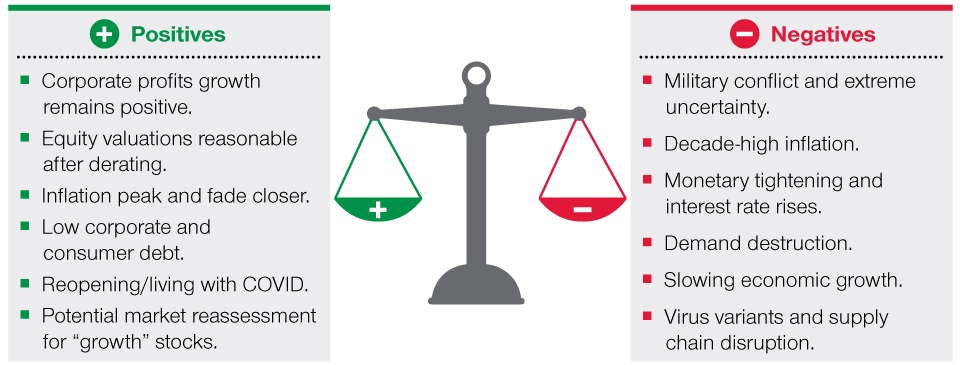October 2022 / INVESTMENT INSIGHTS
Will Signs of Peak Inflation Bring About a Turnaround in “Growth” Stocks?
Headwinds diminishing and valuations now more attractive
Key Insights
- Inflation is having an impact on both consumers and corporates, but signs of demand destruction should bring an inflation peak closer.
- A potential peak in inflation coincides with equity markets that have derated quite significantly, with some stocks trading at extreme valuations.
- Inflation rolling over provides a potential reset for growth stocks, especially for those with the ability to compound and grow earnings through the next stage of the equity cycle.
The U.S. Federal Reserve and other central banks face a complex challenge—how to control extreme inflation while not driving the global economy into a deep recession. The natural inclination for central banks is to ease back on monetary tightening during points of intense uncertainty, but the ability to “go easy” or look through price instability is currently limited given the magnitude of inflationary pressures. The questions for equity investors are: When and how does inflation peak, and how does this impact economic growth and corporate profits, given that these are two of the key drivers (along with valuations) that typically dictate the direction of equity markets?
Signs of Demand Destruction Bring Inflation Peak Closer
We are starting to see the impact of price increases on consumption. While consumer balance sheets are strong after two years of pandemic disruption and employment levels remain high, there are clear signs that consumers are adjusting spending patterns as inflation bites. Demand destruction is, unfortunately, part of the mechanism by which inflation will peak and then fade as economies slow. This is key to confidence being restored for equity investors, especially in longer‑duration growth assets that have had such a torrid period.
Corporates have also been adjusting to inflation as the economic outlook softens. One of the drivers of this inflationary pulse has been wage growth as a strong economy has met with a tight labor market, leading to intense competition for workers. With corporates from Amazon to Uber signaling a recognition of a changing economic outlook and need for greater cost control, the second half of 2022 is likely to reveal a key set of data points surrounding inflation expectations. In our meetings with companies, there is now clearly a message of suppressing workers’ wage expectations, which should act as a further brake on inflation.
Opposing Forces Influencing Equity Markets
Weighing multiple complex factors demands an active approach

As of September 30, 2022.
For illustrative purposes only.
Source: T. Rowe Price.
A weakening economy, wealth destruction through the recent sell‑off in capital markets, and pandemic disruption fading should help ease labor market tightness, abnormal supply conditions, and corresponding inflation pressures. The timing remains uncertain, however, given that higher commodity prices are immediate sources of inflation. Demand destruction and adjustments to workers’ expectations will take time to work through the system as deflationary forces.
Predicting precisely when inflation will peak is a challenge and will vary country by country, but it does feel closer. Equally, measuring how much economic activity will deteriorate given the impact of monetary tightening and high prices is hard to estimate. But strong corporate balance sheets, a lack of systematic risk, and a belief that the U.S. Federal Reserve is trying to avoid a deep recession make us more optimistic for the future.
Valuations and Company‑Specific Factors Make Us More Optimistic
This potential peak in inflation expectations coincides with equity markets that have derated quite significantly, with some stocks trading at extreme valuations. This makes us more optimistic for equities as a whole and is an upgrade on our view versus much of 2022, driven by company‑specific factors as well as macroeconomic data points.
Oil prices remain a key swing factor for financial markets. Oil has backed away from the highs back in June, with the futures curve predicting a normalization at around USD 80 per barrel in mid‑2023 and close to USD 80 in mid‑2024. Yet, the path to lower oil prices is a challenging and uncertain one. This is amplified by the need to structurally increase energy supply and shift European supply lines away from Russia, while also moving the “green transition” forward. An end to the Russia/Ukraine conflict would clearly be a large positive on many dimensions, but this remains an unpredictable situation. Regardless, many commodity prices have already retreated from recent peaks—a trend that will be welcomed by markets if sustained.
Potential for a Reset in “Growth” Stocks
Once inflation peaks, we believe this could potentially be a good signal for “growth” investors, especially for those investing in companies with an ability to compound and grow earnings through the next stage of the equity cycle. This is where we have positioned the Global Focused Growth Equity Strategy. However, in an environment still defined by extreme defensiveness and energy leadership, it may take time to be rewarded, so may require patience.
Indeed, growth stocks have continued to underperform year‑to‑date, with the MSCI ACWI Growth Index falling -32.1% versus the MSCI ACWI Value Index, which has retreated by only -18.6%.1 If there is a positive, however, it is that the weighing machine of capital markets has already priced in a modest recession. This sell‑off has created real challenges for growth investors, but we feel much of the shift away in capital is now complete.
Near term, the outlook for global equities is still highly uncertain, and we do not discount the possibility of further drawdowns. No one “rings a bell” to signal the bottom of the market. But waiting for the backdrop to improve is not the most opportune way to capture future returns. Despite the near‑term uncertainty, we feel more optimistic over the medium term as markets take cues from a rollover in inflation, cheaper valuations and the prospect of less severe monetary policy tightening in 2023.
Risks
The following risks are materially relevant to the portfolio:
Country risk (China)—All investments in China are subject to risks similar to those for other emerging markets investments. In addition, investments that are purchased or held in connection with a QFII licence or the Stock Connect program may be subject to additional risks.
Country risk (Russia and Ukraine)—In these countries, risks associated with custody, counterparties and market volatility are higher than in developed countries.
Currency risk—Changes in currency exchange rates could reduce investment gains or increase investment losses.
Emerging markets risk—Emerging markets are less established than developed markets and therefore involve higher risks.
Small and mid‑cap risk—Stocks of small and mid‑size companies can be more volatile than stocks of larger companies.
Style risk—Different investment styles typically go in and out of favour depending on market conditions and investor sentiment.
General Portfolio Risks
Capital risk—The value of your investment will vary and is not guaranteed. It will be affected by changes in the exchange rate between the base currency of the portfolio and the currency in which you subscribed, if different.
Equity risk—In general, equities involve higher risks than bonds or money market instruments.
Environmental, social, and governance and sustainability risk—May result in a material negative impact on the value of an investment and performance of the portfolio.
Geographic concentration risk—To the extent that a portfolio invests a large portion of its assets in a particular geographic area, its performance will be more strongly affected by events within that area.
Hedging risk—A portfolio’s attempts to reduce or eliminate certain risks through hedging may not work as intended.
Investment portfolio risk—Investing in portfolios involves certain risks an investor would not face if investing in markets directly.
Management risk—The investment manager or its designees may at times find their obligations to a portfolio to be in conflict with their obligations to other investment portfolios they manage (although in such cases, all portfolios will be dealt with equitably).
Operational risk—Operational failures could lead to disruptions of portfolio operations or financial losses.
IMPORTANT INFORMATION
This material is being furnished for general informational and/or marketing purposes only. The material does not constitute or undertake to give advice of any nature, including fiduciary investment advice, nor is it intended to serve as the primary basis for an investment decision. Prospective investors are recommended to seek independent legal, financial and tax advice before making any investment decision. T. Rowe Price group of companies including T. Rowe Price Associates, Inc. and/or its affiliates receive revenue from T. Rowe Price investment products and services. Past performance is not a reliable indicator of future performance. The value of an investment and any income from it can go down as well as up. Investors may get back less than the amount invested.
The material does not constitute a distribution, an offer, an invitation, a personal or general recommendation or solicitation to sell or buy any securities in any jurisdiction or to conduct any particular investment activity. The material has not been reviewed by any regulatory authority in any jurisdiction.
Information and opinions presented have been obtained or derived from sources believed to be reliable and current; however, we cannot guarantee the sources’ accuracy or completeness. There is no guarantee that any forecasts made will come to pass. The views contained herein are as of the date noted on the material and are subject to change without notice; these views may differ from those of other T. Rowe Price group companies and/or associates. Under no circumstances should the material, in whole or in part, be copied or redistributed without consent from T. Rowe Price.
The material is not intended for use by persons in jurisdictions which prohibit or restrict the distribution of the material and in certain countries the material is provided upon specific request. It is not intended for distribution to retail investors in any jurisdiction.

